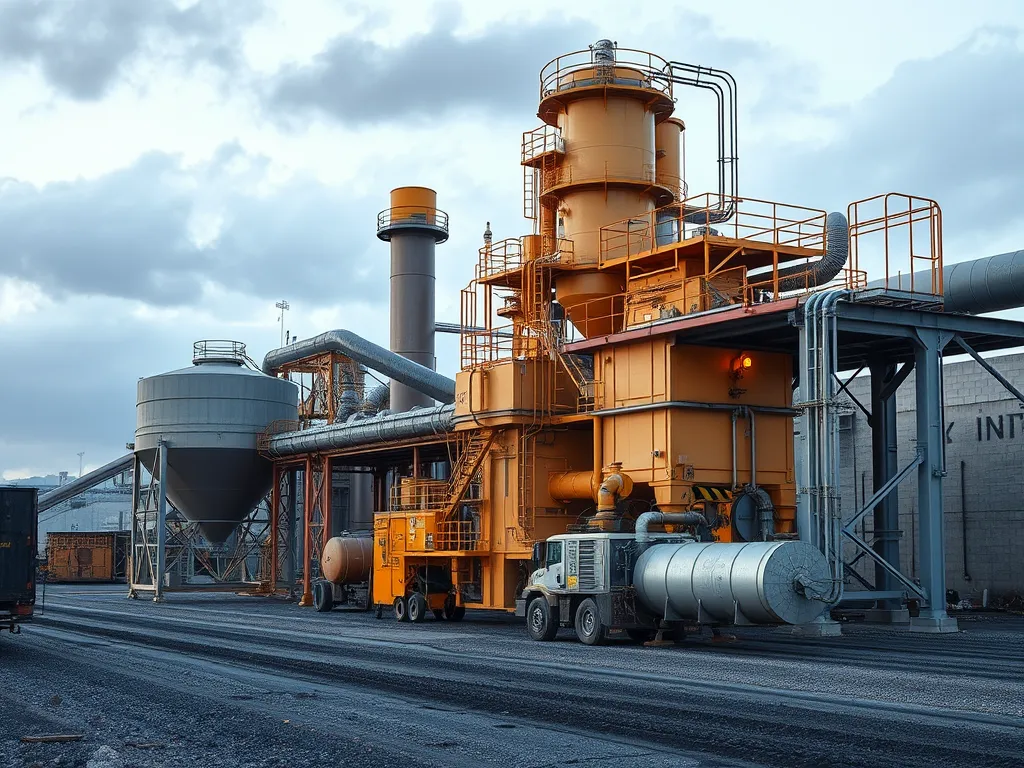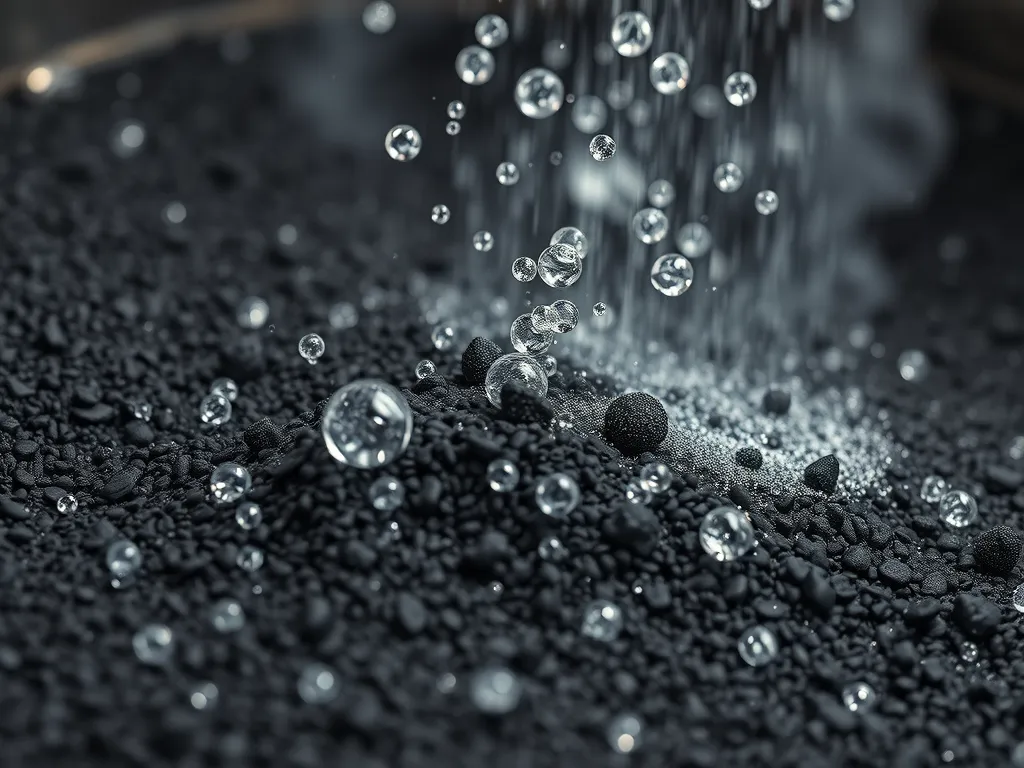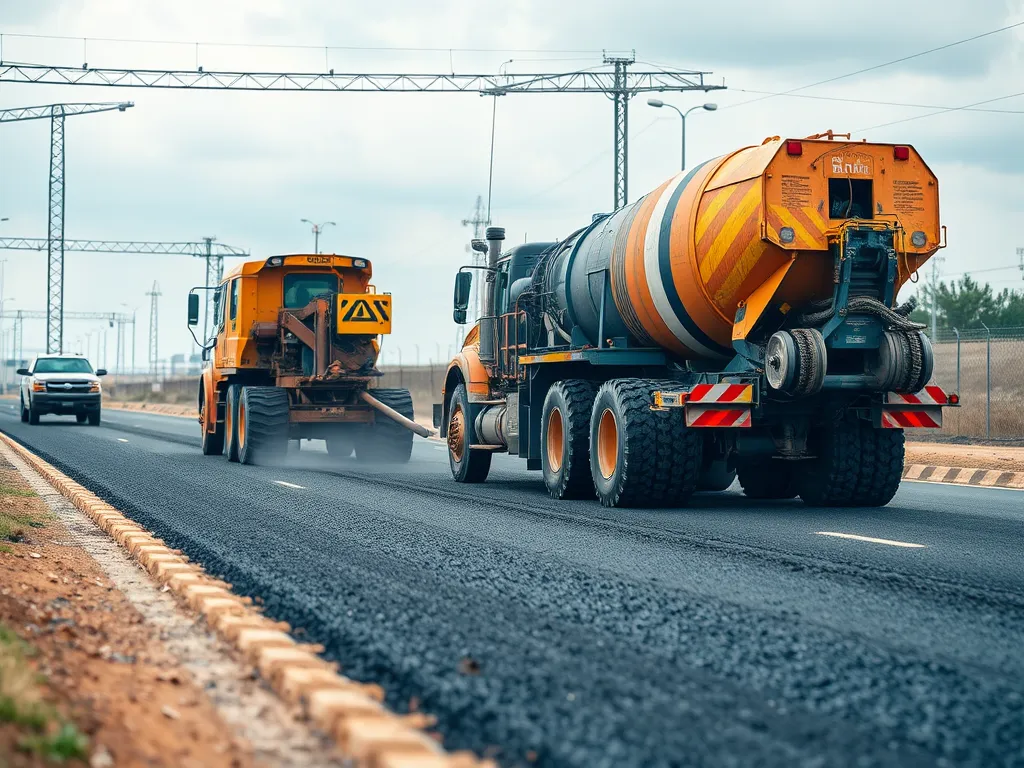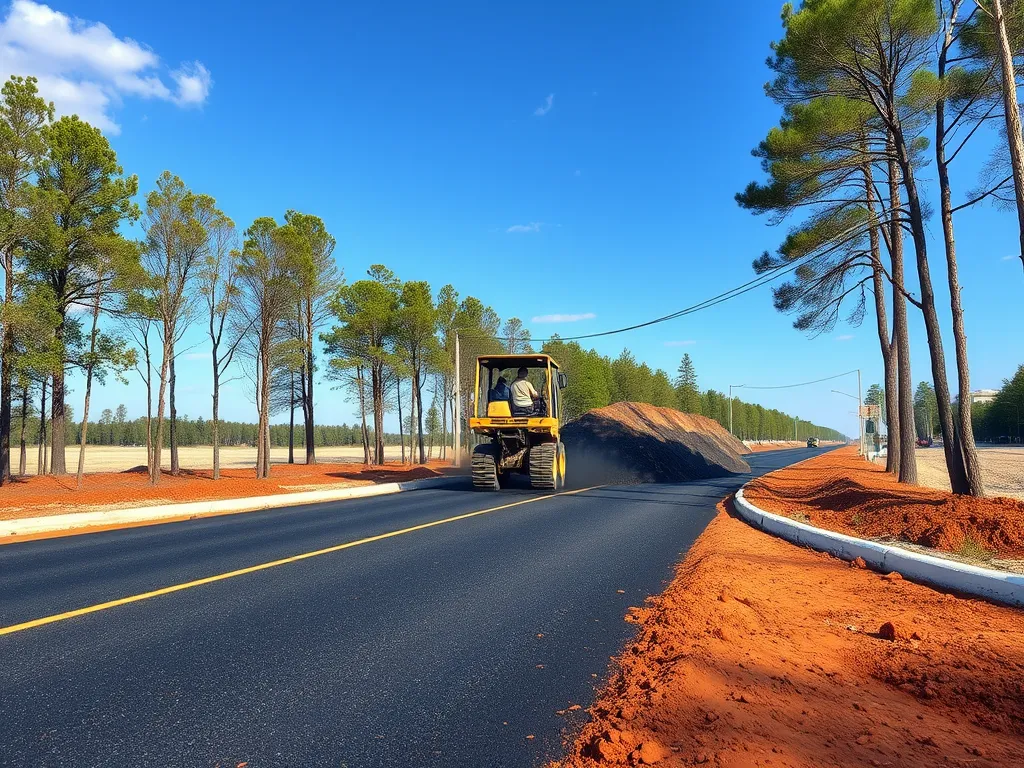Advantages Of Warm Mix Asphalt Over Traditional Methods: Lower Heat, Higher Gains
Published on: May 29, 2025 | Last Updated: April 14, 2025
Written By: George Voss
Warm mix asphalt (WMA) is a modern paving material produced at 250°F to 275°F—50°F to 100°F cooler than traditional hot mix asphalt. This temperature drop slashes fuel use by 20-35% and lowers greenhouse gas emissions by 15-30%. WMA uses additives like waxes or foaming technologies to bind materials at reduced heat. It compacts better in cold weather, extends paving seasons, and supports recycled asphalt pavement (RAP) use up to 50%. Contractors get longer hauling distances, while roads gain durability with fewer cracks.
This article breaks down why WMA beats traditional methods. Compare production temps, additives like zeolites, and costs per ton. See how states like Florida and Ohio use WMA for highways. Learn about emission cuts, energy savings, and safety gains from fewer fumes. Get data on compaction rates, RAP blends, and real-world durability from U.S. DOT studies.
Contents
- Table Of Contents
- What is Warm Mix Asphalt?
- Warm Mix Asphalt Vs. Hot Mix Asphalt
- Key Gains Of Warm Mix Asphalt
- Cost Gains Of Warm Mix Asphalt
- Safety and Health Gains
- Earth Gains Of Warm Mix Asphalt
- What is Warm Mix Asphalt?
- Warm Mix Asphalt Vs. Traditional Hot Mix Asphalt
- Key Benefits Of Warm Mix Asphalt
- Cost Benefits Of Warm Mix Asphalt
- Safety and Health Advantages
- Environmental Advantages Of Warm Mix Asphalt
- Frequently Asked Questions (FAQ)
- Closing Thoughts
- Additional Resources for You:
Table Of Contents
This part breaks down how warm mix asphalt beats old methods. We cover how it works, costs less, keeps crews safe, and helps the earth. Each topic shows clear gains for roads, budgets, and crews.
What is Warm Mix Asphalt?
Warm mix asphalt (WMA) is a smarter way to pave. It uses less heat than hot mix but stays strong. This makes it a top pick for roads, lots, and drives.
Defining Warm Mix Asphalt (WMA)
WMA mixes rocks, sand, and binder (like tar) at lower heat. It needs 30-120°F less than hot mix. This cut in heat saves fuel and cuts fumes.
Heat Range for Warm Mix Asphalt
WMA is made at 220-290°F. Hot mix needs 300-350°F. Lower heat means less fuel burned. Plants save up to 35% on energy costs.
Key Additives and How It’s Made
WMA uses wax, chemicals, or water to flow better at low heat. Foaming tech blows air into the binder, making it puff up. This helps the mix spread smooth.

Warm Mix Asphalt Vs. Hot Mix Asphalt
WMA works like hot mix but with key pluses. Less heat, less waste, same strong roads. Crews can pave in cooler weather too.
Heat Gaps in Making
Hot mix needs 300°F or more. WMA stays below 290°F. This 50-100°F drop slashes fuel use by 20-40% per ton.
Mix Changes and Additives
WMA adds agents like Evotherm or Sasobit to the binder. These let the mix stay soft at low temps. No need for extra glue or rock.
How Well It Works
WMA packs tight, fights cracks, and lasts as long as hot mix. It can handle heavy trucks and cold winters. Tests show equal rut and wear scores.
Also See: Energy Savings in Asphalt Recycling: Benefits for You
Key Gains Of Warm Mix Asphalt
WMA makes jobs faster, cheaper, and greener. Crews spread it easier, even in cool air. Less waste means more miles paved per day.
Easier to Work With
WMA stays soft longer, letting crews pack it tight. This cuts risk of weak spots. Up to 75% better pack rates vs hot mix.
Longer Paving Time
WMA can be poured in temps as low as 40°F. Hot mix needs 50°F or more. This adds weeks to the paving season in cold zones.
Less Waste, Better Sites
WMA cools slower, so trucks can haul it farther. Less mix gets tossed for cooling too fast. Sites see up to 15% less waste vs hot mix.
Cost Gains Of Warm Mix Asphalt
WMA saves cash from start to finish. Lower fuel bills, less gear wear, and fewer fixes over time. Roads last 12-15 years with good care.
Fuel and Energy Cuts
Plants burn 20-35% less fuel to heat WMA. This saves $1.50-$3.00 per ton. Big sites save thousands per job.
Cheaper Hauling and Making
WMA can ship up to 2 hours farther than hot mix. Less need for plants close to sites. Haul costs drop by 10-25%.
Long Life, Less Fixes
WMA roads need 30% less upkeep in the first 5 years. Less cracks mean lower patch costs. Tax funds go farther.

Safety and Health Gains
WMA cuts risks for crews and towns. Less heat means fewer burns, fumes, and lung harm. Sites stay safer for workers and drivers.
Lower Burn Risks
WMA is poured at 50-100°F cooler than hot mix. Crews face less burn risk from gear or spills. Fewer heat stress cases in summer.
Cleaner Air on Sites
WMA makes 30-50% less fumes and smoke. This cuts lung risks for crews and folks near sites. Air tests show lower toxin levels.
Earth Gains Of Warm Mix Asphalt
WMA slashes harm to the planet. Less CO2, less fuel burned, and more old pave reused. Green groups back WMA for clean builds.
Less CO2 and Smog
Each ton of WMA makes 15-30% less CO2 than hot mix. Sites cut smog by 20% per mile paved. This meets strict clean air rules.
Lower Energy Use
WMA needs 20% less power to make. Plants can run shorter hours, cutting grid strain. Solar or wind power can fuel WMA plants too.
Reuse Old Pavement
WMA blends well with recycled asphalt (RAP). Jobs can use 30-50% RAP with no strength loss. This keeps old pave out of dumps.
Next, we tackle common questions on WMA costs, mix types, and real-world use cases.
What is Warm Mix Asphalt?
Warm mix asphalt (WMA) reshapes road construction by lowering production temperatures compared to traditional hot mix methods. This innovation balances performance with lower energy demands, making it popular for modern paving projects.
Defining Warm Mix Asphalt (WMA)
Warm mix asphalt refers to mixtures produced at temperatures 50°F to 100°F cooler than standard hot mix asphalt (HMA). The lower heat reduces fuel use while maintaining workability through specialized additives. WMA meets the same quality standards as HMA but operates under greener conditions.
Temperature Range for Warm Mix Asphalt
Traditional HMA requires temperatures between 300°F and 350°F. WMA cuts this range to 230°F–300°F, depending on additives. Lower heat minimizes emissions during production. For example, PG 64-22 binder-based WMA can be mixed at 250°F without compromising density or strength.
Key Additives and Production Technologies
Three primary methods enable WMA’s lower temps: organic additives, chemical packages, and foaming processes. Sasobit® wax lowers binder viscosity at 185°F. Evotherm® uses surfactants to improve coating. Foaming injects water into hot binder, creating tiny bubbles that boost mix fluidity. Technologies like Astec Double Barrel Green systems cut fuel consumption by up to 20% during production.
With these innovations, WMA sets the stage for comparing performance against traditional methods. Next, we’ll break down how its temperature and material differences translate to real-world benefits.

Warm Mix Asphalt Vs. Traditional Hot Mix Asphalt
Comparing warm mix asphalt (WMA) and hot mix asphalt (HMA) reveals key innovations driving modern road construction. Let’s break down how WMA outperforms conventional methods.
Temperature Differences in Production
WMA production occurs at 212°F–284°F, 50°F–100°F cooler than HMA’s 300°F–350°F range. Lower temps cut fuel use by 20%–35% during heating. This reduces CO₂ emissions by 15%–30% per ton. Plants also cool faster, enabling quicker transitions between batches.
Material Composition and Additive Variations
WMA integrates additives like organic waxes (Sasobit), chemical packages (Evotherm), or water-based foaming. These lower the binder’s viscosity, allowing proper coating of aggregates at reduced heat. Foaming injects 1%–2% water into hot binder, expanding its volume for better workability. HMA lacks these modifiers, relying solely on high temps for mix flow.
Performance and Application Differences
WMA maintains 95%–98% density post-compaction, matching HMA’s structural strength. Extended paving windows let crews work in 40°F weather, vs. HMA’s 50°F minimum. Lower temps reduce thermal cracking risks during cooling. Contractors report 20% faster laydown rates for WMA, plus 12%–18% longer haul distances before mix stiffening. Thin lifts (1.5” vs. HMA’s 2” minimum) are feasible, saving material.
These operational improvements set the stage for exploring WMA’s direct benefits across cost, safety, and sustainability.
Key Benefits Of Warm Mix Asphalt
Warm mix asphalt (WMA) offers clear perks over hot mix methods. From easier handling to lower waste, these gains make it a top pick for modern paving jobs.
Enhanced Workability and Compaction Efficiency
WMA is made 50-100°F cooler than hot mix. This lower heat makes the mix softer and easier to spread. Additives like Evotherm (a wax-based agent) or water-based foaming keep the asphalt workable longer. Crews get more time to compact the mix, hitting target density for roads that last. Better compaction cuts risks of cracks and rutting by up to 40% in some cases.
Extended Paving Season and Temperature Flexibility
Hot mix needs temps above 50°F to set right. WMA can be poured at 40°F or lower, adding weeks to the paving season. Crews in cold zones like Maine or Minnesota gain up to 3 extra work hours per day. This temp range also lets trucks haul mixes farther without cooling issues.
Improved Jobsite Quality and Reduced Material Waste
Less heat loss during hauling means WMA stays usable longer. Sites report 20-30% less waste from hardened loads. Smoother laydown cuts flaws like segregation or mat tearing. Fewer fixes post-pave save crews up to $1.50 per square foot in labor and materials.
These perks in quality and waste set the stage for the next big win: cost savings. Let’s break down how WMA trims budgets from plant to pavement.
Cost Benefits Of Warm Mix Asphalt
Warm mix asphalt delivers measurable financial gains compared to hot mix methods. Lower production temperatures and advanced technologies cut expenses at every stage, from plant operations to road maintenance over decades.
Lower Energy and Fuel Consumption
Producing warm mix asphalt requires temperatures 50°F–100°F lower than traditional hot mix (250°F–275°F vs. 300°F–350°F). This drop slashes fuel use by 20%–35% for burners running on natural gas or diesel. Plants also report energy reductions up to 30% due to shorter heating times and reduced burner strain.
Reduced Production and Transportation Costs
Lower heat levels let plants extend daily production windows and haul mixes farther without cooling. Contractors save $3–$5 per ton on average, with some projects cutting $15,000–$20,000 per lane mile. Less wear on plant components like drums and filters further trims operational costs.
Long-term Durability and Maintenance Savings
Enhanced compaction from warm mix’s extended workability creates denser pavements with 7%–10% fewer air voids. This slows rutting and cracking, extending road lifespan by 25%–30% compared to hot mix. A 2022 FHWA study found agencies save 35%–40% on maintenance over 15 years when using warm mix with polymers or fibers.
Beyond the financial perks, warm mix asphalt also enhances safety for paving crews.

Safety and Health Advantages
Warm mix asphalt benefits extend beyond performance and cost. Lower production temperatures create safer conditions for workers and surrounding communities.
Reduced High-temperature Exposure Risks
Traditional hot mix asphalt requires temperatures of 280°F to 320°F. Warm mix asphalt operates at 212°F to 248°F, slashing heat exposure by 50-100°F. This drop reduces fumes containing volatile organic compounds (VOCs) and polycyclic aromatic hydrocarbons (PAHs) – harmful substances linked to respiratory issues. NIOSH reports a 35-50% decrease in emissions during WMA paving compared to hot mix methods.
Workers face fewer burn risks from overheated equipment or materials. Trucks transporting WMA also stay cooler, lowering the chance of thermal burns during loading or unloading.
Safer Work Environment for Crews
Less smoke and fumes mean clearer visibility at job sites. Crews experience 30-40% fewer respiratory complaints according to OSHA field studies. Reduced odor complaints allow paving in urban areas without disrupting nearby businesses or residents.
- Lower fire hazards from overheated machinery
- Decreased need for respirators in most conditions
- Faster cooldown times let traffic reopen sooner
Contractors using warm mix asphalt technology advantages report 22% fewer heat-related incidents during summer projects. The extended paving window also reduces rushed work in extreme weather.
With fewer emissions and safer sites, warm mix asphalt proves why it’s the smarter choice for modern road projects. Next, let’s examine how these benefits translate to environmental gains.
Environmental Advantages Of Warm Mix Asphalt
Warm mix asphalt (WMA) transforms road construction by merging performance with eco-friendly practices. Its production methods lower environmental strain while maintaining structural integrity, making it a game-changer for sustainable infrastructure.
Lower Greenhouse Gas Emissions
WMA slashes greenhouse gas emissions by 15-30% compared to hot mix asphalt. Lower production temperatures—typically 230°F to 320°F—cut fuel combustion in plants. This reduces carbon dioxide (CO₂) output by over 1,000 pounds per ton of mix. Fewer volatile organic compounds (VOCs) escape during paving, improving air quality near worksites.
Reduced Energy Use and Carbon Footprint
Heating aggregates and binders in WMA requires 20-25% less energy. Traditional hot mix needs temperatures up to 350°F, while WMA operates 50-100°F cooler. This drop lowers fuel use by 1.5 gallons per ton, shrinking the carbon footprint. Plants using foaming technology or organic additives like Sasobit® report yearly energy savings exceeding $15,000 per facility.
Recycling Compatibility and Sustainable Practices
WMA integrates seamlessly with recycled asphalt pavement (RAP), supporting mixes with 30-50% reclaimed material. Cooler temps prevent binder degradation in RAP, preserving its quality. Projects using WMA with high RAP content earn LEED credits for sustainable construction. States like Texas and California report 40% lower virgin material costs when pairing WMA with recycling programs.
Beyond environmental gains, WMA’s versatility sparks questions about performance metrics. Let’s explore common queries next.
Frequently Asked Questions (FAQ)
What Are the Primary Advantages Of Warm Mix Asphalt?
The primary advantages of warm mix asphalt (WMA) include reduced production temperatures leading to lower fuel consumption and emissions, enhanced workability and compaction efficiency, extended paving seasons, and improved jobsite quality with less material waste. These benefits result in cost savings and longer-lasting pavements.
How Does Warm Mix Compare to Hot Mix in Cost and Durability?
Warm mix asphalt generally offers lower production and transportation costs due to its reduced temperature requirements, which also contribute to its long-term durability. WMA pavements have shown to require less maintenance, translating into overall cost savings over time compared to hot mix asphalt.
What Temperature Ranges and Additives Are Used in WMA?
Warm mix asphalt is produced at temperatures ranging from 230°F to 300°F, significantly lower than the 300°F to 350°F required for hot mix asphalt. Common additives for WMA include organic waxes, surfactants, and water-based foaming additives, which help improve mix workability and maintain binder quality at lower temperatures.
How Does WMA Impact Project Timelines?
WMA allows projects to extend the paving season by enabling operations in cooler weather, typically down to 40°F. This flexibility can lead to prolonged work windows and increased productivity, reducing the rush to complete projects before seasonal weather changes.
Can Warm Mix Asphalt Be Recycled?
Yes, warm mix asphalt is compatible with recycling practices and can incorporate 30-50% recycled asphalt pavement (RAP) without compromising quality. This feature supports sustainability goals and reduces the demand for virgin materials.
What Are the Health Benefits Of Using WMA?
Using warm mix asphalt reduces heat exposure and associated health risks for workers. It generates fewer fumes and volatile organic compounds (VOCs), leading to improved air quality at job sites, minimizing respiratory complaints, and contributing to a safer working environment.
Is Warm Mix Asphalt Safer for Nearby Communities?
Yes, the lower emissions and reduced odorous emissions from WMA contribute to better air quality near construction sites. This helps minimize disturbances to local residents and businesses, making it a more community-friendly option for road construction.
Also See: Deicing Strategies for Asphalt Roads: Keep Them Safe

Closing Thoughts
Warm mix asphalt (WMA) presents significant advantages over traditional hot mix asphalt (HMA). By utilizing lower temperatures during production, WMA not only promotes a safer work environment but also reduces energy consumption. Its enhanced workability allows for efficient compaction, extending the paving season even in cooler climates.
Cost benefits are equally compelling. Lower energy and transportation expenses, paired with long-term durability and maintenance savings, make WMA a financially sound choice. Environmental impacts are mitigated as well, with reduced greenhouse gas emissions and a smaller carbon footprint.
For anyone involved in asphalt projects—be it contractors or municipal planners—exploring the benefits of warm mix asphalt can lead to more sustainable, efficient, and cost-effective practices. To learn more about asphalt and calculations relevant to your projects, check out Asphalt Calculator USA.
Additional Resources for You:
- Roberts, F. L., Kandhal, P. S., Brown, E. R., Lee, D. Y., & Kennedy, T. W. (1996). Hot Mix Asphalt Materials, Mixture Design, and Construction (2nd ed.). National Asphalt Pavement Association (NAPA).
- What is Warm Mix Asphalt (WMA)?
- What is Warm Mix Asphalt? A Guide to Asphalt
- Warm Mix Asphalt – an overview | ScienceDirect Topics
- Warm Mix Asphalt FAQs | Federal Highway Administration


